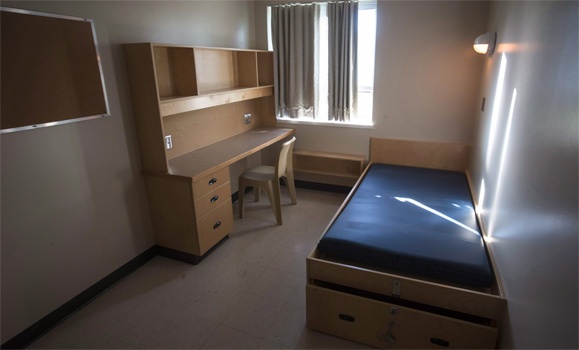ОÓÆÂÁųšÏēĘŋŠ―ąÖąēĨ the authors:Ėý is a PhD Candidate in Nursing at ОÓÆÂÁųšÏēĘŋŠ―ąÖąēĨ. is a PhD Candidate in Political Studies at Queen's University.
In August, the federal prison in Abbotsford, B.C., closed the Annex, its minimum security unit. This closure forced the transfer of all prisoners into higher security units, showing just how much the carceral system fails to create choices for women experiencing criminalization.
We see this failure firsthand: co-author Wendy Bariteau was imprisoned in the Annex and is now a member of the prison abolition collective Joint Effort, Linda Mussell works alongside women who were confined in the Prison for Women (P4W) in Kingston, Ont., and other newer womenâs prisons, and Martha Paynter is a nurse who volunteers inside and outside of prisons with .
Closures and consequences
Thirty years ago, Correctional Service Canada (CSC) published . The report recommended closing P4W in Kingston, Ont. â at that time the only federal prison for women in Canada â and the creation of regional prisons to bring federally sentenced women closer to home communities. The Task Force presented a ânew visionâ of empowerment, respect and dignity, and recognized the role that societal barriers play in womenâs experiences of criminalization.
Scholars such as and , and , have reflected on this legacy and its failures. CSCâs Creating Choices promised âcottagesâ with plenty of outdoor time and space, training, support for mothers, education, health care and trauma counselling.
After , six new prisons for women opened.
Despite the promises, prisoners such as write that the reforms were pointless, and former prisoner and prison abolition activist explains that the changes disappeared âlike bunnies in the magicianâs hat â an illusion.â
Broken systems
In these new prisons, women are incarcerated at an increasing rate; Indigenous and Black women are imprisoned in . Canada locks up nearly 40 per cent more women now than a decade ago, in lockstep with cuts to social services nationwide and . Between 2002 and 2012, the number of Indigenous women in federal custody doubled.
Prisoners have said the system is broken for a long time, as in this narrative from a prisoner at the Fraser Valley Institution: ââ
With each attempt at reforming prisons, the system regresses. This is evident yet again during the pandemic.
Closure of the Annex
The Fraser Valley Institution (FVI) was designed to . The Annex has 20 beds, outside the perimeter fence. Participants in the live there with their children.
Incarcerated women such as Stephanie Deschene have of âpleading outâ to be placed there, âin hopes of not being separated from my child once he was born.â
On Aug. 26, all the people in the Annex were transferred to medium security units without advanced notice or explanation. The Annex is the only minimum security unit for women in the Pacific region, and no minimum security units for men were closed.
Wardens determine a prisonerâs security level classification based on . The mass security level escalation at FVI violates CSCâs own policies.
According to members of , who are in contact with FVI prisoners, FVI states one of the reasons for the move had to do with staffing issues. But these operational challenges translate into human rights violations for women inside: assessed at the same security level as before, the women no longer have the advantages of minimum security. This includes mothers with children. Nearly two months later, the Annex has only begun to reopen.
The ânew normalâ
Before COVID-19, people in prison expressed how difficult it was to maintain connections with their children, families and communities, and to access health care, education and meaningful training. All of this negatively affects transition back to community.
Read more:
COVID-19 has worsened living conditions inside prisons, which CSC describes as â.â
In response to COVID-19, CSC modified or suspended many aspects of its operations- including visits and volunteer support. Legal scholar noted issues with accountability and oversight years before the pandemic. The new restrictions allow for less accountability and more isolation than we have seen in decades.
Volunteer groups already experienced access . They have yet to regain entry since March 2020.
New rules specify a per visit, only two of which can be children. This means parents may not see all of their kids. No physical contact is permitted, visitors must be two meters away and childrenâs play areas are closed. has not resumed, and prisoners will likely face two weeks of isolation if it does. Visits are completely suspended in and .
People inside say they still donât have masks or gloves, are given little access to water or soap and are experiencing crippling isolation. At least have been placed in isolation within their cells since March.
In June, the Correctional Investigator of Canada issued a report . Prisoners have gone on at multiple prisons in response to harsh conditions.
Moving forward
Challenges with safely detaining people during a pandemic should never be met with escalation of security, but rather with a critical examination of .
With a in Manitoba jails threatening the safety of those inside, the need for alternatives is apparent.
Despite ever-declining , and ever-increasing needs for social services in communities hit by COVID-19 and economic collapse, incarceration is an enormous and rising public expense. We must pause and ask if this is the right choice to âcreate choicesâ for the most marginalized people in our society.
Wendy Bariteau co-authored this article.![]()
which features includes relevant and informed articles written by researchers and academics in their areas of expertise and edited by experienced journalists.
ОÓÆÂÁųšÏēĘŋŠ―ąÖąēĨ is a founding partner of The Conversation Canada, an online media outlet providing independent, high-quality explanatory journalism. Originally established in Australia in 2011, it has had more than 85 commissioning editors and 30,000-plus academics register as contributors. A full list of articles written by ОÓÆÂÁųšÏēĘŋŠ―ąÖąēĨ academics can be found onĖý

